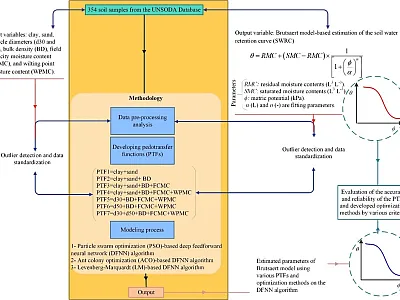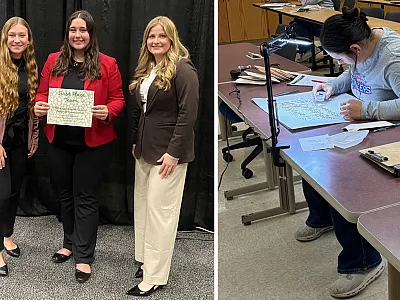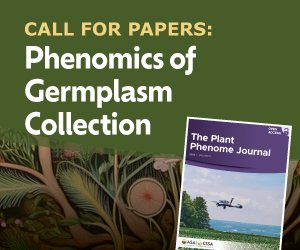Orange-Fleshed Sweet Potato Truly an Emerging Superfood in Ethiopia
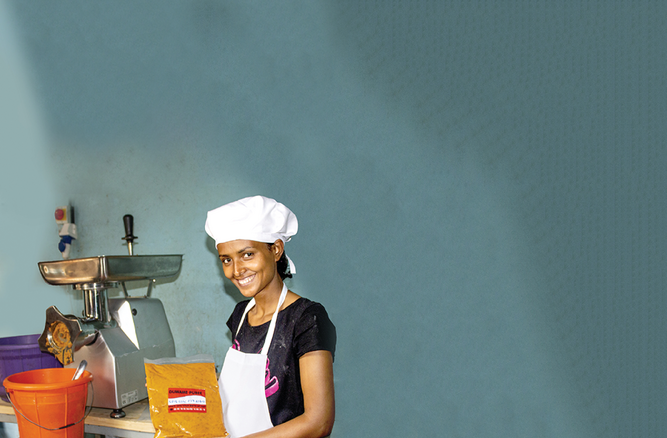
Substituting this colorful root vegetable for flour in bread or white‐fleshed sweet potatoes in daily cooking can tackle the prevalent vitamin A deficiency in the African country and throughout sub‐Saharan Africa.
Nearly half of preschool‐aged children in Ethiopia are deficient in vitamin A, a deficiency that leads to blindness, stunted growth, and even death. As of 2019, some 30–49% of children under age 5 were considered stunted. Vitamin A deficiency kills 80,000 people annually in Ethiopia—and 600,000 or more annually around the world, predominantly young children or expectant mothers. Yet the problem could be solved, scientists say: One baseball‐sized amount of orange‐fleshed sweet potato a day meets the daily vitamin A requirements for a small child, offering a simple yet effective remedy.
While addressing vitamin A deficiency seems straightforward—and it is, in a lot of ways—distributing orange‐fleshed sweet potato (OFSP) presents its own set of challenges. Scientists aren’t giving up though. They’ve figured out and cultivated different varieties of sweet potatoes appealing to both adults and children. Puree made from OFSP can cost‐effectively replace 30–60% of wheat flour in baked goods. They’ve created toolkits to help mothers know how much and how frequently to feed their kids. They’ve gotten the OFSPs into the hands of farmers, rural households, and sellers. And they’ve created a massive marketing campaign emphasizing the health benefits of orange foods. Orange‐fleshed sweet potato, pumpkin, mango, papaya, carrots—all contain beta carotene, the dietary precursor to vitamin A.
The results of the interventions so far are promising. Crop Science has published a special section stemming from research presented at the 12th Triennial African Potato Association Conference; two of the papers in the section suggest a decline in vitamin A deficiency as OFSP is becoming more common across Ethiopia and sub‐Saharan Africa thanks to these interventions.
Solving the vitamin A issue—and other forms of malnutrition—in sub‐Saharan Africa isn’t going to take just one type of intervention, says Jan Low, an emeritus scientist with the International Potato Center (CIP) in Nairobi and a 2016 World Food Prize co‐laureate. It’s not an “either/or” situation, she says. It’s going to take behavior change interventions at the household level to have more diverse diets; an improved vine multiplication and distribution system; marketing and education campaigns; policy reform; more biofortification and healthy soils research; and more.
Why Focus on OFSP?
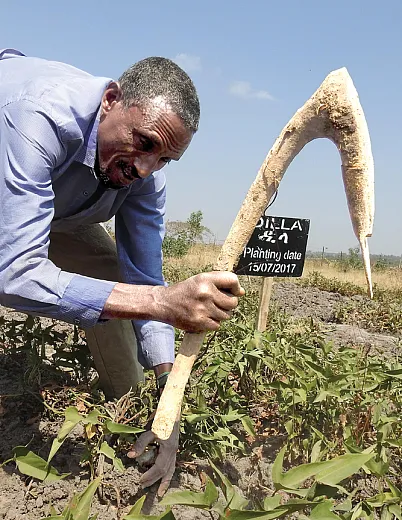
Sub‐Saharan Africa grapples with malnutrition for two primary reasons: either lack of sufficient calories (undernourished) or lack of a quality diet full of vitamins and minerals (micronutrient malnourished). Sub‐Saharan Africa has the highest incidence of chronic hunger in the world. It also has the highest rates of “hidden” hunger: micronutrient malnutrition. Diets across the region rely on staple foods like maize, rice, and wheat for half to three‐quarters of daily calories, and fruits, vegetables, and animal products are inadequately consumed as they are too expensive for most people. The wheat and maize people rely on are usually stripped of their bran to make white flour, so they don’t even have fiber or micronutrients left. When a micronutrient‐poor food accounts for 50–75% or more of a person’s diet, micronutrient deficiencies abound. This is especially the case for young children in Ethiopia, who are primarily fed a thin porridge from wheat or maize. If households enhanced porridges with diverse ingredients of the appropriate thickness, including OFSP, they could significantly better the young child diet, Low says.
Orange‐fleshed sweet potato provides an excellent source of vitamin A and is a good source of vitamins C, E, K, several B vitamins, and minerals like potassium and manganese. Low says OFSP also provides fiber and natural sugars, making it a great energy source. In the West, OFSP has been named a “superfood” for its nutritional content. The roots have been found to increase blood levels of vitamin A, especially when eaten with a fat source.
"Orange‐fleshed sweet potato provides an excellent source of vitamin A and is a good source of vitamins C, E, K, several B vitamins, and minerals like potassium and manganese."
But it’s not just the roots that can be eaten. The leaves also provide an excellent source of micronutrients like lutein, which prevents eye degeneration, Low says. You can cook them like collard or turnip greens, and they have even more protein than many leafy vegetables. Vines and leaves can also be fed to livestock, which increases milk output in dairy cows by 20% or more. Furthermore, growers use the vines or the sweet potatoes themselves to propagate the crop from year to year. “No part of the plant goes to waste,” Low says.
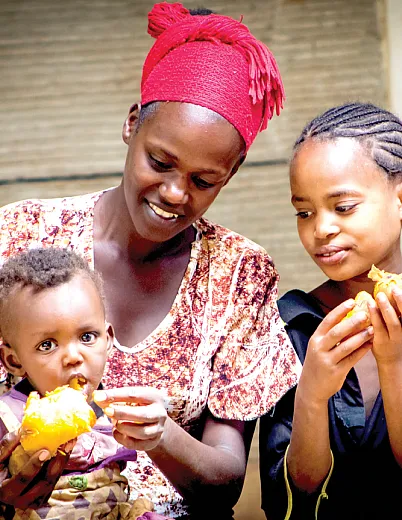
How easily and where the plant grows also makes OFSP a popular choice for nutritionists trying to solve the vitamin A crisis in Africa. It grows across the tropics, from sea level to 2,400‐m elevation, Low says. Hardy and versatile, OFSP can produce two to three crops per year for harvest, and once established, it can withstand droughts, “so it really fits into a system under stress” due to the changing climate, Low says. Furthermore, “it has a lot of genetic diversity” that allows breeders to select varieties adapted to many different microclimates and soils, from hot, sandy soils at the coast to cooler volcanic soils on high plateaus. There are more than 3,000 different varieties of sweet potato maintained in the global genebank at the CIP headquarters in Peru.
Agronomic Interventions
Since they started working on introducing OFSP to sub‐Saharan Africa in 1985, CIP and researchers have bred more than 100 different “biofortified” varieties of OFSP in the region, says Joel Ranck, head of communications at CIP.
Scientists develop new biofortified varieties of OFSP through conventional, yet accelerated breeding techniques, which are also described in the special section of Crop Science. “Biofortification means having a very high content of at least one key micronutrient bred into a staple food—so it is a source of energy and a micronutrient essential for good health,” Low says… Biofortification is not genetic modification. Developing a new variety of OFSP takes about four years of field trials under diverse agroecological pressures through breeding for desirable traits such as virus resistance, drought tolerance, and of course, high levels of beta‐carotene and good eating quality, Low says.
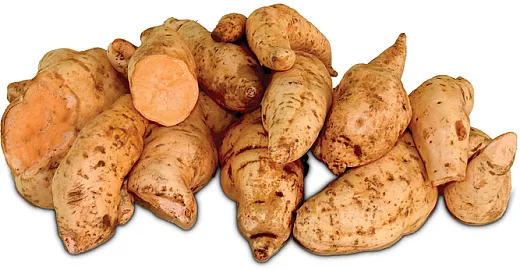
First, researchers determine what benefit a particular OFSP has that they want to marry with another—for example, one variety is resistant to a particular pest that’s prevalent in an area and another has the right texture that consumers in that area want for eating. Then they make crosses of these varieties, and test under different soil and climatic conditions—see what works. Once they develop a new variety, they test it on farms and with traders and consumers. Then they keep the best crop “parents” and start the process anew until they get exactly the OFSP traits they want. Over nearly 40 years of research, scientists at CIP and elsewhere have tested a lot of sweet potatoes, Ranck says.
Some of the varieties they have developed are to address taste preferences. In the United States, consumers tend to like moister OFSPs, the type we’d make into a sweet potato pie or a sweet potato casserole at Thanksgiving. Those have about 18–22% dry matter, Low says. Kids in Africa also tend to like that texture, but adults largely don’t, considering it watery. Most African adults tend to prefer drier, mealier OFSPs with about 28–35% dry matter. So providing different varieties to meet varying preferences and uses (boiled, roasted, baked, and fried) helps get the sweet potato into wider use, Ranck says.
Other varieties developed by CIP and other researchers are more drought tolerant, more pest or disease resistant, or higher yielding, says Temesgen Fitamo Bocher, a former agricultural economist with CIP and Save the Children who is now at World Vision Canada. The crop already produces high yields from small plots, he says, which makes it ideal for a backyard garden or a small farm. But it can also scale up easily for bigger farms to sell into marketplaces in urban areas. However, he says, there has to be a market—people willing to buy the product—before farmers will start growing large amounts of sweet potatoes.
Social and Household Interventions
Creating a market is indeed one of the biggest challenges to even wider‐spread adoption of OFSP throughout Ethiopia and sub‐Saharan Africa, Low says. That starts by reaching consumers—largely women. Where there’s been success so far—Kenya, Uganda, and Ghana, for example—it’s been because outreach has focused on community‐based nutrition programs to reach rural women and men with young children and school‐feeding programs for older children, Ranck says. In school‐feeding programs, he says, OFSP has been offered for lunch—getting kids to try it and like it—and then the school hands out vouchers for kids to take home to their parents to get OFSP vines from growers. Then they grow it at home in their kitchen garden, which provides a significant source of food security in rural areas.
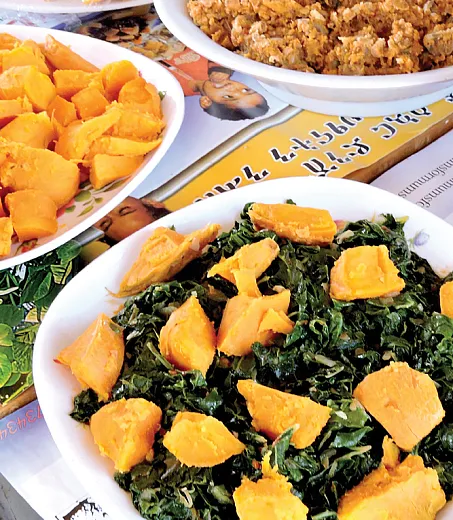
Reaching women can also start at prenatal clinics for pregnant women, Bocher says. Many pregnant women in sub‐Saharan Africa are vitamin A deficient as are many lactating women with newborns. They need the vitamin themselves, but they also need to pass it along to their babies. One such intervention is through provision of the Healthy Baby Toolkit to mothers with children under age 2. It’s a bowl with lines and symbols that show the appropriate volume of food and frequency of feedings for children of varying ages, from six months through two years old, and it comes with a slotted spoon to help parents judge the optimal thickness of the ubiquitous porridge. The idea is that the optimal porridge has a consistency that can’t drip through the spoon. The bowl also has a line that indicates the amount of additional food a pregnant or lactating mother should eat daily.
Many parents don’t know how much to feed their infants or toddlers, Bocher says. Nor do they know how often to feed them or what consistency their food should be. They often underfeed their kids by accident, feeding too little, not often enough, or with porridge that’s too thin. The bowl and slotted spoon take the guesswork out of it.
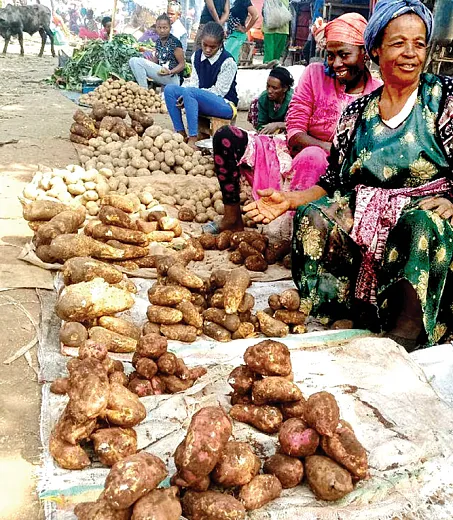
Bocher, Low, and Roland Brouwer of Zanguela in Mozambique studied how the Healthy Baby Toolkit, developed by Emory University, worked in concert with other OFSP interventions in southern Ethiopia (https://doi.org/10.1002/csc2.21090). Participants—15,000 rural households with pregnant and lactating women, infants, and young children—were given the toolkit, nutrition education, 600 OFSP vine cuttings to plant on their land, and training in improved farming practices. “We saw a statistically significant impact,” Bocher says. “That encouraged us to continue intervening.” They not only saw increases in intakes of vitamin A (estimated based on food intake surveys), but also observed increases in food security and dietary diversity, he says, even though the area was impacted by drought during the study. Participants reported having more to eat and more variety in their diet during this study.
The Healthy Baby Toolkit has proven so effective, in fact, that UNICEF, the World Food Programme, and other organizations that intervene during food crises have started handing it out, Low notes. It’s really a “breakthrough innovation,” she says.
But that intervention alone doesn’t make as much of a difference in the diets of young families as using the Healthy Baby Toolkit in concert with the providing access to quality seed of nutritious crops like OFSP and enhanced nutrition education, Bocher says.
Another intervention that’s proven effective in providing a nutritional boost involves replacing some of the wheat flour and teff flour in bread and injera, a fermented flatbread widely consumed in Ethiopia, with OFSP puree. Asheber Mengesha, a nutritionist at CIP in Ethiopia, and colleagues studied the nutritional content of bread and injera that had varying amounts of OFSP puree replacing flour in the two grain products (https://doi.org/10.1002/csc2.21132). They tested textures and flavors to determine the most popular ratios (ranging from 15% OFSP puree with 85% wheat or teff flour to 45/55 OFSP puree to wheat/teff) and then tested the beta carotene levels in the bread and injera.

“In both grain products, beta carotene contents exhibited an increasing trend as the proportion of OFSP puree blended with wheat and teff flours increased from 15 to 45%,” Mengesha says. Consumers generally found all of the products “acceptable” to eat, Mengesha and his team reported, but best “sensory qualities” combined with high beta carotene levels were bread and injera made from 30% OFSP puree and 70% wheat or teff flour. Therefore, grain products made from the 30/70 blend “is recommended for commercial production and consumption among urban and rural consumers, including the most vulnerable groups to vitamin A deficiency,” he says.
Replacing 30% of wheat flour with OFSP in 100 g of bread “can contribute to 52% and 47.2% of vitamin A to two‐to‐three‐ and four‐to‐five‐year‐old children’s recommended daily allowance, respectively,” Mengesha and his team wrote. Likewise, replacing 30% of teff flour with OFSP puree in 100 g of injera “can contribute to 54% and 48% of vitamin A to two‐to‐three‐ and four‐to‐five‐year‐old children’s recommended daily allowance, respectively.”
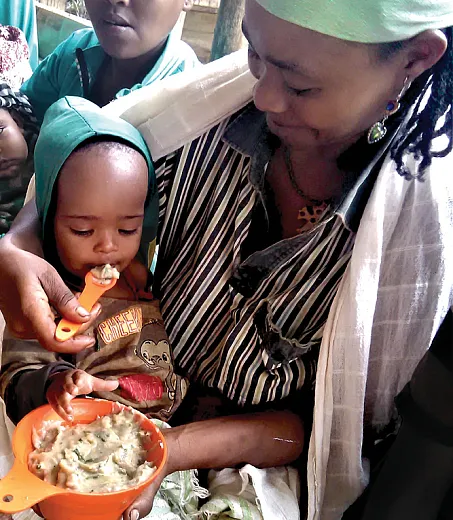
The golden‐hued bread produced with OFSP also has other benefits, the team reported, such as better shelf stability, softer texture, and less microbial growth than standard bread. Additionally, OFSP offers economic advantages: OFSP is cheaper than wheat flour and can be grown locally, and the price and demand for wheat and teff grains have been increasing, making them unaffordable to low‐income consumers.
Injera is usually made in the home while bread is usually bought at a market, especially in urban areas, Mengesha notes. Thus, to get this intervention widely accepted will take a strong value chain. Farmers are needed to grow the roots, the bakery industry is needed to process the OFSP and make the breads, traders or markets are needed to sell the baked goods, and consumers need to purchase the products. “All of these different actors play a valuable role,” Mengesha says. Even the government needs to get involved to start incentivizing and promoting OFSP to partially substitute for maize or wheat flour, he adds.
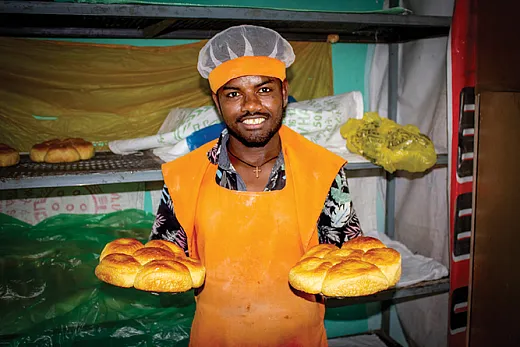
Fortunately, CIP is working with the government of Ethiopia on a strategy to increase OFSP uptake throughout the country, Mengesha says. The International Potato Center is also promoting OFSP through social and traditional media campaigns, such as using influencers and radio ads. Other governments in sub‐Saharan Africa are also working with CIP to increase adoption of OFSP.
The International Potato Center has already gotten OFSP into more than 7 million households across Africa, Ranck says, which is a good start.
Future Work
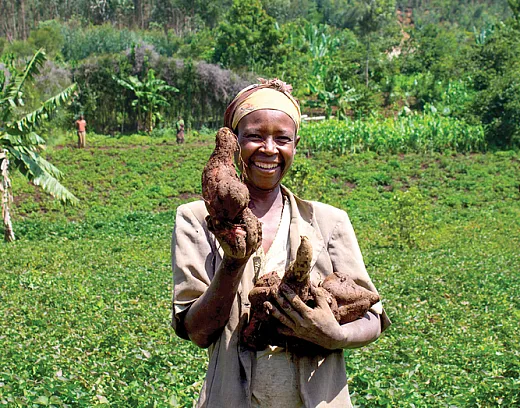
Despite progress, challenges remain, particularly regarding seed distribution and soil degradation. Probably the single biggest challenge facing OFSP adoption is the seed business, Low says. Because OFSP grows from vines—growers can store vines cut from last season and plant them again—there’s little money to be made in seeds, so commercial operators aren’t interested. Thus, as of now, there just aren’t enough vines to go around unless there is strong government or nongovernmental organizational support. Another problem with this system though is that over time, vines recycled year after year can become affected by viruses, which can lead to lower yields or other problems. Growers need periodic access to disease‐free “clean seeds,” Low says. “Hence, we have been promoting combined ‘vine root enterprises’ where trained quality vine multipliers also engage in commercial root production. When demand for vines for planting is low (when farmers retain and replant their own vines), multipliers can convert their vines into root production for sale.” This will be key to the value chain working, she says. Typically, it takes grant organizations or government support to get the vine‐enterprise system set up, and then CIP and others need to work with local farmers to help them realize the value of clean seed.
Soil degradation is an even harder challenge to solve, Low says, as it varies significantly. But breeding OFSP to be able to tolerate poor soils and harsh conditions is possible so that’s another line of research.
Overall, Low says, though there’s more work to be done, “sweet potato has proven itself to be a climate‐smart intervention that contributes toward building the healthier food system the world needs.” These interventions “make a difference.”
DIG DEEPER
The special section stemming from research presented at the 12th Triennial African Potato Association Conference is published in the May‐June issue of Crop Science and can be viewed at: https://bit.ly/4bXPNwy.
The two papers specifically mentioned in this article are available at:
Brouwer, R., Bocher, T.F., & Low, J.W. (2023). Quality diets for better health: Integrated orange‐fleshed sweet potato intervention improved dietary practice in southern Ethiopia. https://doi.org/10.1002/csc2.21090
Mengesha, A.K., Getahun, D., Gebeyehu, S., & Brouwer, A.R. (2023). Evaluation of nutritional value, consumer preference, and profitability of orange‐fleshed sweet potato puree–incorporated bread and injera. https://doi.org/10.1002/csc2.21132
Text © . The authors. CC BY-NC-ND 4.0. Except where otherwise noted, images are subject to copyright. Any reuse without express permission from the copyright owner is prohibited.





